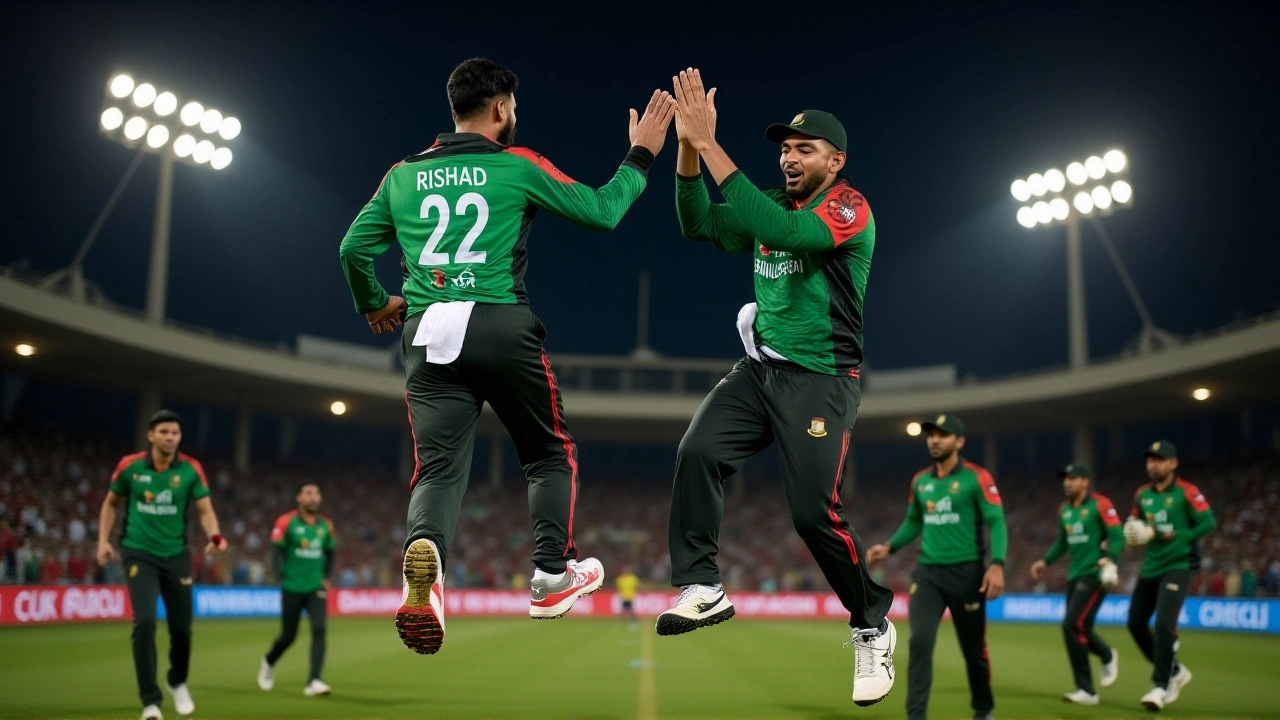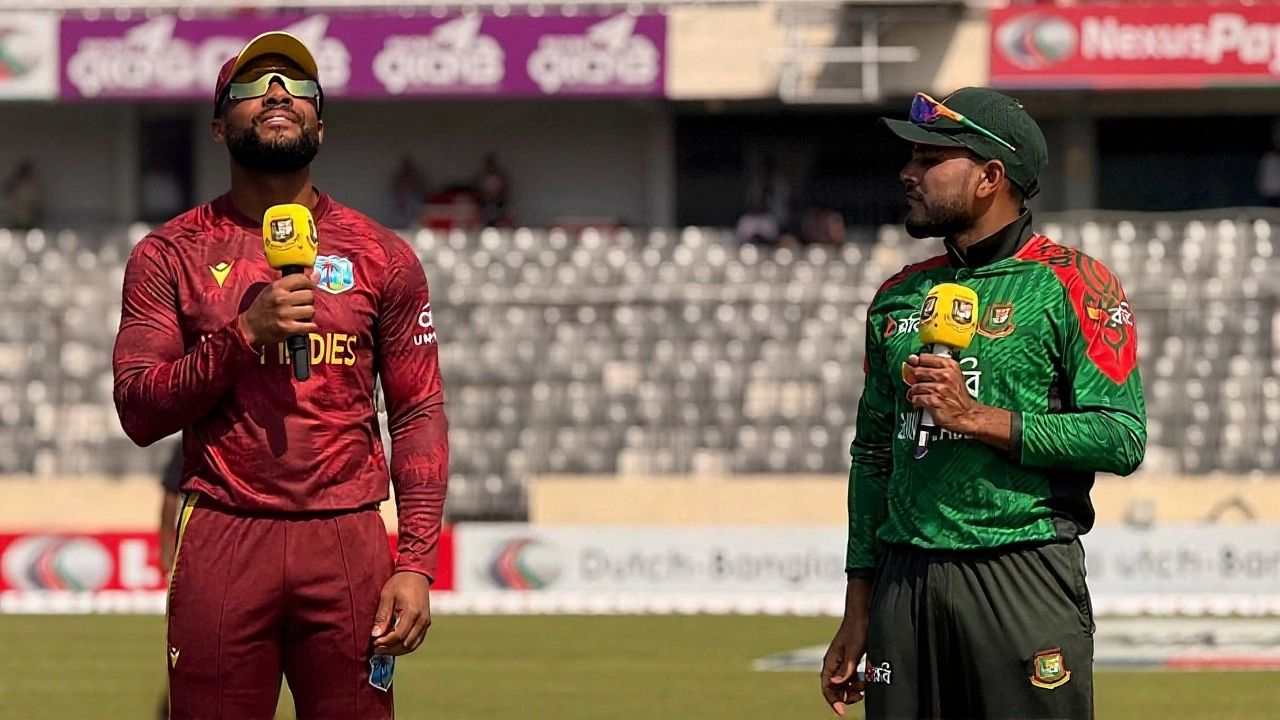When West Indies posted 165/3 against Bangladesh on Monday, October 27, 2025, at the Bir Shrestho Flight Lieutenant Matiur Rahman Cricket Stadium in Chattogram, it wasn’t just a win — it was a lifeline. For the first time in over two years, the Windies had broken a seven-match T20I series losing streak. And for Bangladesh, whose last five bilateral T20I series wins had them dreaming of a sixth, it was a gut-punch. The final scorecard read 165/3 vs. 149 all out — a 16-run margin that felt heavier than the numbers suggest. West Indies didn’t just win. They reminded everyone they still have teeth.
Powering Through the Chase
West Indies won the toss and, against the grain of recent T20 trends, chose to bat. It was a bold call — Chattogram’s pitch had offered turn in the ODIs, and Bangladesh’s spinners, led by Rishad Hossain, were in form. But Rovman Powell, the captain, had other ideas. His 44 not out off 31 balls — laced with three sixes and four fours — was the anchor. He didn’t dominate; he controlled. And when he was joined by Shai Hope, the wicketkeeper-batter who’s been the quiet backbone of the Windies’ middle order, the innings found its rhythm. Hope’s 46 not out came at a strike rate of 148, a masterclass in late-order composure. The pair added 67 in just 5.3 overs. Brandon King (33) and Alick Athanaze (34) laid the foundation, but it was Powell and Hope who turned pressure into points.Bangladesh’s bowling attack — led by Taskin Ahmed and Rishad Hossain — looked sharp early but faded under pressure. Taskin, who took two wickets, was economical but couldn’t break the partnership. Rishad, promoted to No. 7 after his ODI heroics, was taken off the attack after 3 overs. The run rate crept from 7.1 to 8.25. That’s not a collapse. That’s a calculated demolition.
Chasing Shadows
Bangladesh’s chase began with promise. Litton Das and Soumya Sarkar added 47 in 6.1 overs, but the moment Litton Das was caught off Jason Holder — the veteran all-rounder who had been quietly building pressure — the momentum shifted. The crowd, which had been roaring since the first ball, fell silent. Wickets tumbled. Not in clusters, but in drips. One every two overs. Like a slow leak in a boat.It was Jayden Seales who delivered the knockout blows. The 23-year-old fast bowler, playing only his fifth T20I, finished with 3/27 in four overs. His yorker to dismiss Mushfiqur Rahim with 18 needed off 12 balls was a thing of beauty — low, fast, and lethal. Holder matched him with 3/31, including the key wicket of Najmul Hossain Shanto, who looked set at 38 before a misread length sent him back. Bangladesh’s run rate hovered around 7.6 for most of the chase. But when they needed 8.6 runs per over in the final eight overs, their rhythm vanished. They scored just 42 off the last 36 balls.
Why This Matters
This wasn’t just about breaking a losing streak. It was about identity. For West Indies, the last seven T20I series defeats — against South Africa, India, Australia, and even Sri Lanka — had eroded confidence. Fans stopped showing up. Analysts called them “overhyped.” The 2024 T20 World Cup exit was fresh. But Powell’s leadership, Hope’s calmness, and Seales’ raw pace sent a message: the old spirit isn’t gone. It’s just been waiting.For Bangladesh, the loss is a reality check. They’d won four straight bilateral T20I series — against Afghanistan, Zimbabwe, Ireland, and now the ODIs against West Indies. They entered this match as favorites. But T20 cricket doesn’t reward momentum alone. It rewards execution under pressure. And when the lights shone brightest, Bangladesh’s lower middle order blinked. The 100-run mark came in 14.4 overs — fine. But they scored only 49 runs in the final 6 overs. That’s not bad luck. That’s a structural flaw.

What’s Next
The second T20I is set for the same Chattogram venue on Wednesday, October 29. Bangladesh will need to rebuild their middle order — perhaps promoting Tanzim Hasan Sakib or Mohammad Naim — and find a way to contain Powell and Hope. West Indies, meanwhile, will look to give Seales more overs and maybe bring in Shimron Hetmyer for more firepower. The series is still wide open, but the psychological edge has shifted. For the first time since 2023, the Windies believe they can win. And that’s the most dangerous thing in cricket.Behind the Numbers
- West Indies scored at 8.25 RPO — their highest in a T20I innings since July 2024. - Jayden Seales’ 3/27 is the best bowling figures by a Windies paceman in T20Is since 2022. - Bangladesh’s 149 is their lowest total in a T20I chase against West Indies since 2018. - Rovman Powell’s 44* is his highest T20I score since 2022. - The 16-run margin is the narrowest win for West Indies in a T20I against Bangladesh since 2019.Frequently Asked Questions
How did Jayden Seales emerge as a key player in this match?
Jayden Seales, a 23-year-old fast bowler making only his fifth T20I appearance, delivered a breakthrough performance with 3/27 in four overs. His ability to bowl tight yorkers under pressure — especially the dismissal of Mushfiqur Rahim with 18 needed off 12 balls — turned the tide. This was his first three-wicket haul in T20Is and the best by a Windies pacer since 2022, signaling his arrival as a genuine finisher in the death overs.
Why was Rovman Powell’s innings so crucial for West Indies?
Powell’s unbeaten 44 off 31 balls wasn’t flashy — it was strategic. With the top order falling early, he stabilized the innings when the required run rate was climbing. His partnership with Shai Hope added 67 runs in under six overs, turning a decent total into a match-winning one. This was his highest T20I score since 2022 and his first fifty-plus innings in the format in over two years, proving he’s stepping up as a leader under pressure.
What does this loss mean for Bangladesh’s T20I momentum?
Bangladesh had won four consecutive bilateral T20I series and were aiming for a historic fifth. This defeat exposes a recurring issue: their lower middle order collapses under pressure. Despite strong starts, they’ve now lost three of their last five T20I chases where the target was above 150. Without a reliable finisher, their aggressive batting style becomes a liability — especially against disciplined death bowlers like Seales and Holder.
Is this win a sign of a West Indies revival?
Absolutely. After seven straight T20I series losses — including defeats to lower-ranked teams — this win breaks a psychological barrier. Powell’s leadership, Hope’s calmness, and Seales’ pace show depth beyond the usual stars. The Windies haven’t won a T20I series since 2023. If they win the next two matches, it won’t just be a series victory — it’ll be a statement that they’re back in the conversation.
How does this match compare to past West Indies-Bangladesh T20I encounters?
This 16-run win is the narrowest margin for West Indies against Bangladesh in a T20I since 2019. Historically, Bangladesh had dominated in Chattogram, winning all three previous T20Is there since 2021. But this time, West Indies’ bowling attack — particularly Seales and Holder — outperformed Bangladesh’s spin-heavy attack. The run rates and death-over performances were starkly different, indicating a shift in tactical balance.
What’s the significance of the venue, Bir Shrestho Flight Lieutenant Matiur Rahman Cricket Stadium?
Known locally as Zahur Ahmed Chowdhury Stadium, this ground has been Bangladesh’s fortress in T20 cricket — they’ve won 11 of their last 13 T20Is here. But this match proved that even home advantage can’t compensate for poor execution under pressure. West Indies’ ability to post a competitive total and then defend it on a pitch that favored spinners earlier in the week shows their adaptability — a key trait missing in their past performances.
